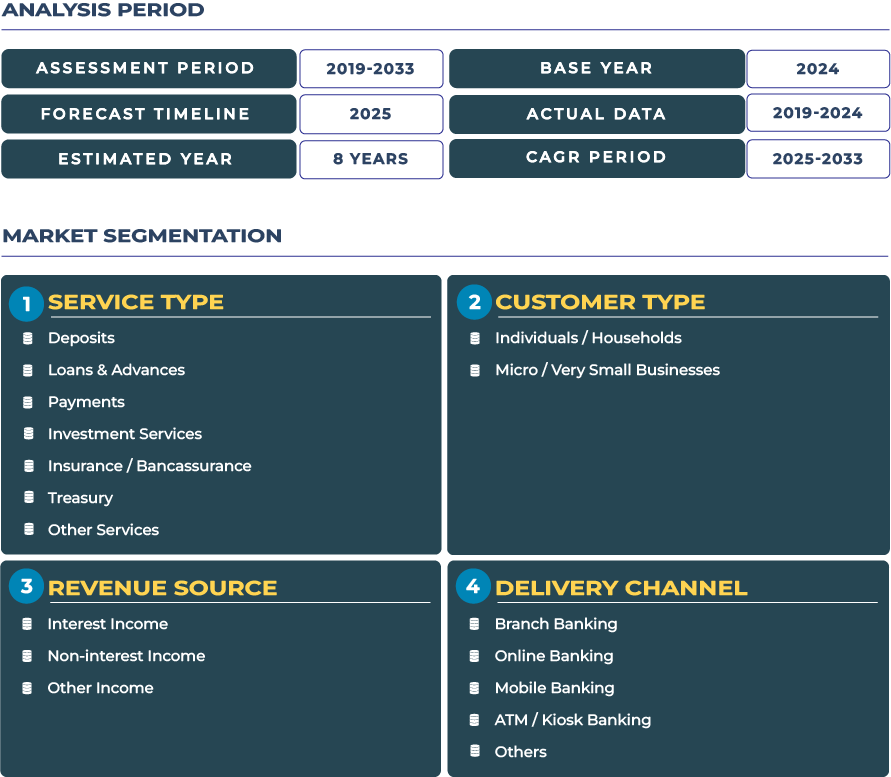Fully Digital Banking & AI Customer Service: Nordics Poised for Next-Gen Retail Finance
The Nordic region is widely regarded as a global leader in digital banking adoption, where customers expect seamless, personalized financial service delivered via mobile and AI-powered chat interfaces. In Sweden, for instance, the BankID digital identification system covers a vast majority of smartphone users, enabling secure logins, e-signatures, and instant payments. With open banking systems deeply entrenched and trust in digital infrastructure high, Nordic banks are accelerating investments in AI chatbots, predictive analytics, and autonomous customer support.
Note:* The market size refers to the total revenue generated by banks through interest income, non-interest income, and other ancillary sources.
Market Outlook: Charting the Digital Trajectory of Nordic Retail Banking
From 2025 to 2033, the Nordic retail banking sector is projected to grow from USD 43.1 billion to USD 55.7 billion, an effective CAGR of 3.2%. While deposit, mortgage, and consumer lending volumes remain the backbone of the business, the real upside lies in digital monetization-payments revenues, real-time lending, embedded insurance, and advisory services. The Nordics benefit from high per capita income, stable macroeconomics, and strong institutional infrastructure. Yet, challenges remain: margin pressure, global interest rate volatility, and cost inflation in IT and regulation. Banks that can combine lean cost structures, high automation, and high customer engagement will be well positioned to extract value from this growth trajectory.
Drivers & Restraints: Deep Currents Shaping Nordic Banking Futures
Digital Maturity, High Penetration & Open Banking Adoption
A key driver is the exceptionally high level of digital banking penetration. Across the Nordic countries, over 92% of consumers use online banking, and mobile payments and open banking APIs are ubiquitous. Contactless payments are dominant-recent reports show that in many Nordic markets, more than 90% of in-store card transactions are contactless. This digital readiness creates fertile ground for embedding richer financial services directly into customer apps and platforms. In addition, Nordic fintech ecosystems are sophisticated, with companies such as Hudya in Norway aggregating financial, telecom, energy and banking services on a unified digital platform. Together, these drivers enable Nordic banks to scale digital transformation more swiftly and reliably than many peers globally.
Constraining Headwinds: Cyber Risk, Privacy & Regulatory Complexity
However, the very sophistication of digitalization in the Nordics also brings elevated risks. Cybersecurity threats are more pervasive, requiring continuous investment in identity protection, fraud systems, and resilience. Regulatory oversight is high: GDPR, PSD2, and national financial supervisory mandates demand rigorous data governance, explainability in AI, and strong consent frameworks. The margin compression from low interest environments and high operational costs-especially in staffing, IT infrastructure, and compliance-are persistent constraints. Moreover, population aging and slow growth in some markets (e.g. parts of Sweden) may temper demand for new lending lines.
Trends & Opportunities: Innovation Fronts in Nordic Retail Banking
Trend: Expansion of Fully Digital Branches, Mobile Wallets & Embedded Interfaces
One major trend is the virtual “branch” model-full banking capabilities delivered via app without physical presence. Nordic banks are reducing branch footprints while investing in immersive mobile UX, AI assistants, and in-app cross-product flows. Digital wallets and account-to-account payments are also growing rapidly: mobile wallet penetration in the Nordics is estimated in the 83–94% range-well above European averages. In payments, the shift from card dominance to a mix of digital wallets, A2A (account-to-account) rails, and open banking flows is maturing. Such trends reduce friction and open new monetization pathways in payments, micro-lending, and loyalty services integrated in wallets.
Opportunity: AI-Driven Service Platforms & Neobank Collaborations
A key opportunity lies in advancing AI–powered platforms-chatbots, predictive analytics, and personalized nudges-to deliver 24/7 customer service, cross-sell modelling, and proactive financial advice. Because consumer trust is high, AI features embedded inside core banking apps are more likely to gain acceptance. Another salient opportunity is partnering or integrating with neobanks and fintechs to capture niche segments. Banks can also license modular fintech components-credit decisioning, alternative underwriting, payment modules-to achieve faster speed-to-market. Collaboration with platforms or digital ecosystems (retail, mobility) to embed banking offers is also appealing. As digital adoption deepens, incumbents that orchestrate experiences across lending, payments, wealth and insurance will maximize share of wallet.
Competitive Landscape: Strategic Moves Among Nordic Banking Institutions
Leading Nordic banks include Nordea, SEB, Swedbank, DNB, and Handelsbanken. Nordea is aggressively expanding digital services across the region, investing in shared digital platforms and cloud infrastructure. SEB and Swedbank continue to strengthen advisory and wealth services integrated with retail banking. Recently, Swedbank and SpareBank 1 announced the formation of a joint Nordic investment bank to expand corporate and capital markets capabilities. On the fintech front, platforms like Settle (formerly Auka) provide PSD2-compliant mobile payment infrastructure to banks. Meanwhile, challenger banks such as Noba in Sweden are scaling rapidly: Noba recently announced plans for a $3.7 billion IPO to fuel expansion in digital consumer credit. In this environment, differentiation is increasingly defined not by balance sheet size, but digital agility, data platforms, AI-powered customer insight, and seamless omni-channel continuity across Nordic markets.







